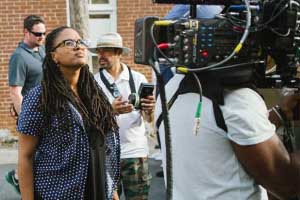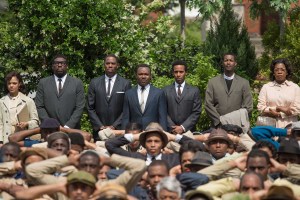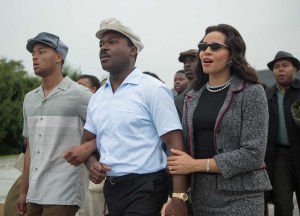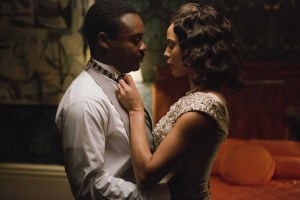
Selma chronicles Dr. Martin Luther King Jr.’s three-month long campaign to secure equal voting rights against violent opposition via an epic march from Selma to Montgomery, Alabama in 1965. When they began working on the film, the filmmakers never guessed that the story would be so timely, paralleling the current marches for racial justice and the renewed struggle against systemic racism in America.
David Oyelowo, cast as King, wanted to keep the project alive when the director attached to the film fell out. He had worked with director Ava DuVernay on Middle of Nowhere, which won both the Sundance directing award and the John Cassavetes award at the Independent Spirit Awards. “He [Oyelowo] had suggested me. More than suggested me. Pitched me. Cajoled them to really consider me. By the time I got the call, they were just asking if I wanted to do it,” shared DuVernay. “He did a great job pitching me for it.”

After DuVernay came on board, she worked to craft a film that was more than a standard biopic “where you’re just going through historical events like you’re checking off a timeline.” Her intent was to get “under the skin” of Dr. King, presenting him as a complex man. She wanted to show a sense of his humanity as he approached historic events, as opposed to focusing on hero-worship. “That was the charge for all my key collaborators and department heads,” explained DuVernay.
The director previously worked with cinematographer Bradford Young. According to DuVernay, the success of their collaboration starts from a place of cultural nuance. “I don’t have to explain to him what I want when I am creating an image of the black body, and a black intellectual, and kind of a black family, and black love. There is something embedded in the image that is different. I think we should approach cinematography from a place of cultural nuance.”
 DuVernay noted the way a Southern Baptist church looks in the afternoon, filled with people of color of all hues. She knew a scene like that needed to be photographed differently, but she did not need to have that kind of conversation with Young. Because they were both familiar with those spaces and what they should look like, they had a shorthand.
DuVernay noted the way a Southern Baptist church looks in the afternoon, filled with people of color of all hues. She knew a scene like that needed to be photographed differently, but she did not need to have that kind of conversation with Young. Because they were both familiar with those spaces and what they should look like, they had a shorthand.
“He has such a beautiful eye when it comes to taking great care with people of color. We’ve had challenges in the past just as a film lover watching images of people of color on screen,” explained DuVernay. “If you have a black person and a white person in a scene together, traditionally the D.P. lights for the lighter skin tone, which creates a bit of an ashy grey effect on the darker person in the scene, whether they are black, Latino, or a very tanned white person. You light for the light. Bradford has a completely different creative approach and that is part of our conversation.”
Although the filmmakers used some black-and-white archival footage at the very end of the film, the bulk of the film was shot on the ARRI Alexa XT Plus, with a digital intermediate timed by supervising digital colorist, Mitch Paulson.
 In her research, costume designer Ruth Carter delved deeply into the historical context of not just the time period, but also of the characters. She considered who the characters were class-wise, what they did for a living, and what they might have worn in their quiet moments.
In her research, costume designer Ruth Carter delved deeply into the historical context of not just the time period, but also of the characters. She considered who the characters were class-wise, what they did for a living, and what they might have worn in their quiet moments.
Carter even put what DuVernay described as “emotional detail” into the background extras, “The church things were very interesting because you had lower class people, who might have worked as domestics, yet they were at church with Dr. King, a public figure, so their church clothes would not have been fine and fancy, they would have been a bit tattered, but they were doing their best. That’s the kind of work that Ruth does and why she is such a legend.”
DuVernay pointed out that as an artist, Carter created “amazing paintings and portraits of the work as she envisioned it, not just a regular sketch. This stuff was fine art that you could hang on the wall.” As inspiration for the narrative that the whole team was telling, her art was circulated through all the departments.
Despite the small budget, Mark Friedberg, production designer for The Amazing Spider-Man 2, came to Selma straight from work on Noah. “He wrote me a letter talking about his emotional connection to this material because his parents had been very active as Jewish liberals in the movement in New York at the time. He had a beautiful connection and brought all that love and care to the sets and really made them come alive.”
The director and production designer communicated by sharing videos, photographs and interviewing people together. Friedberg, alive during the ’60s, shared his own recollections of sitting in churches with his own relatives in the South. He created a look book that also circulated among departments.
“Location scouts, hair and make-up, everyone was trading photographs,” said DuVernay. “It was like trading cards. I found this. I found that. Look at the hair in this. Look at the carpet in that. It was a really beautiful collaboration between everyone involved.”
DuVernay and editor Spencer Averick started out on their first film together. The director thinks it has been wonderful growing up with another filmmaker, perfecting the craft together. Averick has cut everything that she has made.
“He has cut my Venus Williams documentary, my short film for Prada, and every single film that I do, and he always will,” said DuVernay. “We began to learn film grammar together. We try to break those rules together. He has grown into one of the finest editors in the business, highly sought after now, but for some reason he likes to work with me. That’s great. There is no one else I would rather sit in the dark with for eight hours than Spencer.”
Although shooting on location can pose challenges for sound, DuVernay stated, “It was never an issue,” because she had two-time Oscar-winning production sound mixer, Willie Burton, on set. “I knew that I was in good hands. He’s a master at what he does. He took care of it. It was important for me to have him there.”
DuVernay worked with the Formosa Group and supervising sound editors Andy Koyama and Greg Hedgepath for the first time on Selma. In terms of sound, it was important to DuVernay for the vitriol and violence in the film to feel visceral and urgent.
She feels there has been a watering down of films about the civil rights movement, and that it was essential “to articulate the terrorist state that people lived under in the Deep South at that time. It was important for me to make that violence feel very real, very front-and-center for the viewer. That was a conversation I had constantly with Willie on set, as well as with Andy and Greg on the design and the mix.”
The Bloody Sunday sequence in particular was “much enhanced by attention to sound in every single frame.” Sound was used to create the chaos and terror that occurred that day, but it was also central in generating the quiet moments of a Southern day. “Greg did an amazing job letting me hear the water in a stream and the cicadas,” said DuVernay. “There was a really nuanced, thoughtful, emotional approach to the sound in every single scene.”
The film’s schedule for both shooting and post was very tight. The shoot was 32 days, wrapping on July 4, 2014. The edit lasted through September. The first screening was Nov. 11. There were constant previews for the studio while the filmmakers were trying to tighten up the story. Only a month was allowed for the final finishing before the filmmakers began showing the film publically as a work-in-progress. “It was a nightmare,” exclaimed DuVernay.
The condensed schedule essentially meant that it took all hands on deck to get the film finished by the Christmas Day release. “Everything was collapsed on top of each other,” DuVernay explained. “All teams were working simultaneously – VFX side-by-side with sound, side-by-side with music, side-by-side with editorial as Spencer and I were cutting actively. That was the only way to get it done in time for the Christmas holiday.”
Despite the compressed schedule, DuVernay looks back and feels, “It was all worth it, because to have the film done now in its cultural moment – where there is so much unrest, and protest, and really important issues that we address in Selma – to have the film ready to meet that cultural moment, I believe all those late nights and all of that frenzy of abbreviated post schedules was really worth it in the end.”





